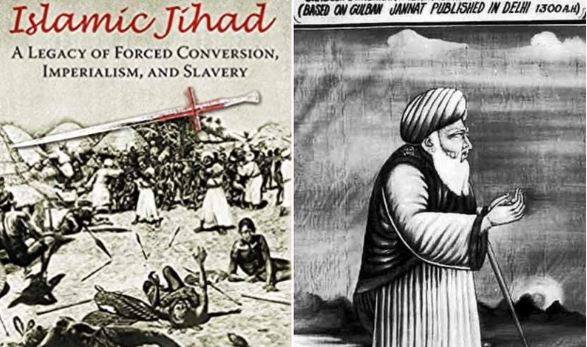“Oh, but Sufis are so peaceful, cute and moderate!”
“Sufis are the best Muslims around!”
“I love the Sufi philosophy. It’s so mystical!”
“Sufis are secular, tolerant and lovers of music.”
Have you heard any of this? Chances are, you have. Well, it’s all a load of bunkum. These are all lies. Sufis are not non-violent. If the Sufi history of Kashmir is anything to go by, they are just as violent and bigoted as their Salafi and Wahhabi (Sunni) counterparts.
Such lies were spread for Shias as well not very long ago. How did that turn out? Iran today funds the greatest number of militias and extremist organisations across the Middle East. The Iranian regime is among the most radical of Islamic governments. Similarly, the lies surrounding the “mystical sect” of Sufis need to be demolished as well.
Sure, there was maybe a time in history when Sufis were non-violent and among the more moderate Islamic sects. But they were not even considered ‘Islamic’ by the powers that were and were persecuted. Continuous persecution seems to have turned Sufis into the very monsters that they were meant to challenge, and that is why the narrative of them being lovers of music and dance needs to be debunked.
How Indian Sufis Aided in the Slaughter of Hindus and Non-Muslims
Let’s talk about Kashmir first, shall we? It was around 1350 AD that the first Sufis arrived in Kashmir. Sayyid Ali Hamadani was a Sufi from Hamadan in Iran. He brought along a large number of followers into Kashmir. Under the patronage of Shihabuddin’s son, Qutbuddin, he began preaching feverishly. As the Hindu’s of Kashmir did absolutely nothing to counter the Sufi influence, Sayyid had a free hand, coupled with the sultan’s patronage. For the first time in Kashmir’s history (in 1371), a dress code was promulgated for all Hindus – an Islamic dress code.
Sayyid Ali’s son, Mir Muhammad came to Kashmir in around 1393. Kashmir was then under the rule of one Sikandar, the son of Qutbuddin. Both Mir Muhammad and Sikandar had one goal– the complete and total Islamisation of Kashmir. And for this, Mir Muhammad would take the epithet of ‘Butshikan,’ which in Persian translated to ‘the idol smasher.’
Mir Muhammad came with more than just an army. He came with large groups of alien-faith militants. These were Afghan and Iranian Muslim thugs that acted as faith police – demolishing shops, wine breweries, musical instruments and implementing Sharia at the street level. These were Sufi orders arriving from Eastern Iran which acted as strong street-level enforcer units. So much for Sufis loving music!
Read more: How Kashmir – the land of Shiva and Surya turned into an Islamist base
Timur invaded Eastern Iran, and he expelled many of the Sufis out of the region. These refugees came over the Himalayas into Kashmir, and in them, Sikandar saw an opportunity. By bringing them into Kashmir with royal patronage, he was not only able to skew the demographics in his favour but also had a private army of radicals. Hindu villages were depopulated, massacred and burned. Many Hindus simply ran out of Kashmir. The Bayhaqi Sayyids – the post-Timurid exiles from Iran, now entered into the lands the Hindus had abandoned and settled therein. Most of Kashmir’s Hindu heritage had been wiped clean by 1410.
Close to 400 years later, the Sufi onslaught was reversed by Sher-e-Punjab Maharaja Ranjit Singh, who drove a good many of the Afghan and Iranian settlers out of the valley.
Sufi Saints or Mass Murderers?
Khwaja Moinuddin Chishti and Nizamuddin Aulia. Heard these names before? Of course, you have. The former has the Ajmer Sharif dargah to his credit, while the latter manifests in Delhi’s Nizamuddin.
But here are some facts. Moinuddin Chisti fought for Mohammad Ghauri and Nizamuddin Aulia fought for Alauddin Khilji. Sufi leaders like these came to India alongside Turkic invaders, all of whom held the radical Ulemas (orthodox Islamic scholars) in high esteem. Sufi saint Nasiruddin Chiragh, for one, had banned all practices that were not in compliance with sharia.
Another Sufi saint, Imam Ghazzali had instructed his followers to wage jihad at least once a year to bring down the fortresses of non-Muslims. References for the same can be found in MA Khan’s book ‘Islamic Jihad: A Legacy of Forced Conversions, Imperialism and Slavery,’ where he quotes Prof KA Nizami to describe what Ghazzali’s true inclinations were.
Meanwhile, Nizamuddin Aulia, according to the same book, had condemned the Hindus of India to the ‘fires of hell’. According to this gentleman, even if Hindus were to convert to Islam, they could not get rid of the ‘sin’ of being a Hindu. According to Nizamuddin, “He, (Allah) has created paradise and hell for the believers and the infidels respectively to repay the wicked they (infidels) have done.”
“Khwaja mere khwaja
Dil mein sama jaa
Shaho ka shah tu
Ali ka dulara”
Indians love this song. But do they know the reality of ‘Khwaja’?
Moinuddin Chisti, referred to as ‘Khwaja’, was among the very first Sufi saints to arrive in India. He set base at Ajmer in Rajasthan. Ajmer was replete with Hindu temples. So, Mr Khwaja devised a daily routine for himself. According to MA Khan’s book, every day, Chisti’s followers used to bring a cow and used to slaughter it near a prominent Hindu temple. They then cooked kebabs using the slaughtered cow’s meat. This is the Sufi culture you have never been told about.
Moinuddin is said to have played an active role in the war by Mohammad Ghauri against Prithviraj Chauhan. It is also said that he had encouraged forced conversions, slavery and kidnapping of Hindu women.
Today, lakhs of people pay obeisance at Ajmer Sharif and Nizamuddin – many among them Hindus. Why? Because the pop myth of Sufis being tolerant has been mainstreamed in India, nobody seems willing to speak the truth about the sect’s violent history in the country.

































Bhosdiwalo genocide ka spelling toh seekhlo karne se pahile ₹2 ke chamcho